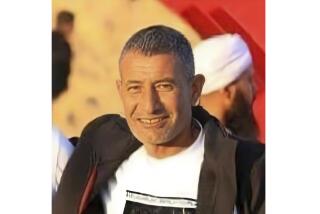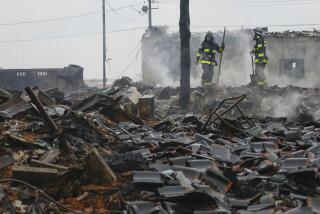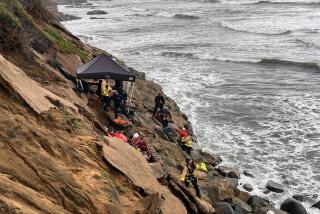Finding teen in Nepal earthquake rubble lifts rescue workers’ spirits

<p>Rescuers pulled a 15-year-old boy alive from the rubble of Nepal’s earthquake April 30, bringing a rare moment of joy to the ruined capital Katmandu.</p>
- Share via
Reporting from Katmandu, Nepal — Los Angeles County Fire Capt. Andrew Olvera was up early Thursday morning, scouting the streets of Nepal’s capital. The burly Californian and fellow members of a disaster response team deployed by the U.S. Agency for International Development were looking, against all odds, for collapsed buildings that might still have people trapped alive five days after a devastating earthquake.
Since arriving in the country Monday, Olvera’s squad and one from Fairfax County, Va., had found many bodies but no survivors. Then, just after 9 a.m., a local government official with Olvera received a report that Nepalese police searching through the rubble of a collapsed hotel with an excavator had heard someone shouting from inside.
When he reached the site in Katmandu’s Gongabu district, Olvera saw that the nine-story building had been flattened. But beneath the twisted iron rods, chunks of concrete and torn blankets, a slight 15-year-old boy, Pemba Lama, had announced to the world that he was alive.
“He cried for help, but it was very difficult to make access to him,” said Laxman Bahadur Basnet, the Nepalese police officer who first made contact with the boy.
“He thanked me when I first approached him,” Basnet said. “He told me his name, his address, and I gave him some water. I assured him we were near to him.”
For the next three hours, the Americans and Nepalese worked together to extricate the teenager. Cameras brought by the Americans allowed the teams to see exactly how he was trapped and determine the most efficient way to rescue him, Olvera said.
“He was entombed; the building was pancaked, but if you can imagine, he was in a box.”
All the while, Basnet talked to the teen. When enough rubble, including a motorbike, had been cleared to allow him to crawl toward Pemba, Basnet said, the boy began softly singing to him, “You are a god who has come to me to try to save me.”
Shortly before noon, Basnet reached Pemba. Above the youth was a heavy metal shutter, and as Basnet tried to extricate the boy, the shutter began to fall. Basnet propped it up with a little jack and pulled Pemba out.
The midday sun was an assault on the teen’s eyes after days of being trapped in the dark. Covered with dust, but otherwise suffering only minor scrapes, cuts and dehydration, he was put on a stretcher and carried toward the main street. Hundreds of onlookers sent up a cheer as he was driven off to an Israeli field hospital.
Pemba’s rescue was one of two reported Thursday, a rare bit of good news in a city that has known little but despair since the magnitude 7.8 earthquake hit Saturday, leaving more than 5,800 people dead across this impoverished Himalayan nation. A woman in her 20s was pulled from the rubble near the capital’s main bus terminal, the Associated Press reported, citing police.
On Tuesday, a French team rescued a 27-year-old man from a collapsed apartment block in Katmandu.
Thirty-two search teams from 15 countries, comprising 1,200 specialists, have been sent to Nepal since Saturday. But on Wednesday, a senior Nepalese army officer, Brig. Gen. Davendra Bahadur Medhasi, urged in a letter to the Ministry of Home Affairs that the foreign squads be sent home because he said there was no chance of finding more survivors, the Himalayan Times newspaper reported.
The Nepalese Armed Police Force supervisor at the scene Thursday, Narayan Thapa, said such a suggestion was premature.
“We can find more people,” he said. “It depends on the willpower of the people.”
From his bed in a medical tent, Pemba recounted his long ordeal as an Israeli paramedic held his thin left arm, which bore a tattoo of the Hindu god Shiva.
“I saw something bright outside as the excavator moved the rubble around me, and then I screamed for help,” Pemba said flatly.
As the days wore on with little food and no water, he said, he suffered horrific hallucinations.
“There were times when I thought I was dead, and then I would wake up again to find myself beneath the rubble,” he recalled. “I survived on ghee [clarified butter] that I found in a bottle there, scraping until the last dollop to feed myself.”
The team treating him at the Israeli medical camp in the Chhauni area was surprised to find Pemba not just alive but in such good condition.
“This is nothing short of a miracle to find him alive after five days, and that too with no major injury; he was only dehydrated,” said Dr. Sakhi Dagan, who was overseeing Pemba’s treatment.
When the earthquake began, Pemba, a hotel employee, said, “I hurried downstairs from the cash counter.... After that everything came crashing down.” Several hours later, he woke up and found himself in the rubble.
Pemba told his rescuers that he had been able to speak with two other children trapped in the debris, a girl of about 6 and a boy age 12 or 13, until about 4 a.m. Thursday. But rescue workers could not be sure whether those voices were real or a figment of Pemba’s imagination.
Chris Schaff, a battalion chief with the Fairfax County Fire Department, said Pemba was the U.S. team’s first live rescue since arriving in Nepal.
“It gets a little discouraging near the end” of the survival window, he said, “so it was great to be able to assist the Nepali rescue team on this.”
Olvera, a fire captain based in Palos Verdes, called Pemba “a very fortunate young man.”
“He obviously has a strong will, to be in there six days and come out talking to us,” Olvera said.
The USAID disaster assistance response team, or DART, consists of 57 personnel from Fairfax, 57 from Los Angeles and 12 search dogs, six from each county.
Aid continued to flow Thursday into hard-hit areas northwest of the capital. In Gorkha, near the quake’s epicenter, trucks delivering relief supplies plied the winding mountain roads.
Around midday, three patients, including a teenage boy with apparently serious leg injuries, arrived at the bare brick main hospital in an ambulance from the nearby village of Panch Kuwa Deurali. Swiss relief workers and Nepalese police officers loaded one woman onto a stretcher, covering her grimacing face with a scarf to shield her from the sharp sunlight.
The number of dead and wounded has been rising steadily as relief teams access more villages. The government has announced that it will provide about $1,000 to families of the deceased.
But an estimated 75,000 people are still camping outside in the Katmandu Valley alone, the United Nations said, because either their homes are uninhabitable or they feared returning to their cracked structures. Engineering professors from a local university announced Thursday that they were forming an 18-member task force to help evaluate the structural integrity of buildings in the capital.
At the site where Pemba was found, the search continued into the evening for the other two reportedly trapped people.
Occasionally, an eerie hush fell over the site as authorities asked for complete silence so their listening devices would not pick up stray sounds.
Though hope remained for the children, the smell of rotting flesh pervading the site indicated that bodies were buried under the debris.
Pemba, from the Nuwakot district, west of Katmandu, said he came to the capital a few years ago as his mother was about to leave for a job in the Middle East; many Nepalese work abroad to send money home.
“I first worked as a bus conductor for a few months before starting work at the hotels in Katmandu,” he said.
He indicated that he was no longer very close with his family and said he had never been to school. Even after the ordeal, he seemed to be focused on returning to his job.
“I want to be able to work again soon,” he said, “but I don’t know.”
Rai is a special correspondent. Times staff writer Shashank Bengali in Gorkha contributed to this report.
Twitter: @JulieMakLAT
More to Read
Sign up for Essential California
The most important California stories and recommendations in your inbox every morning.
You may occasionally receive promotional content from the Los Angeles Times.











